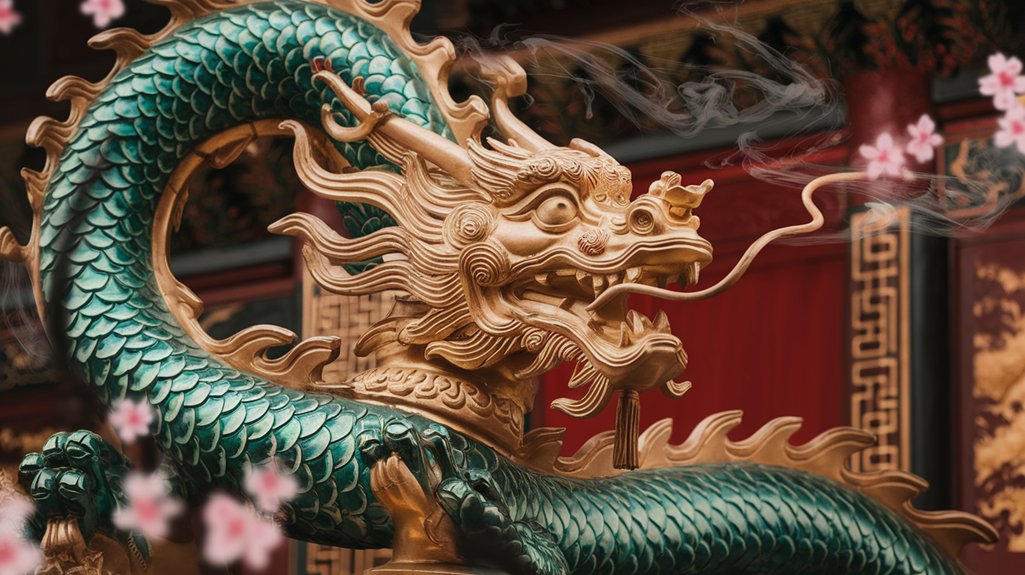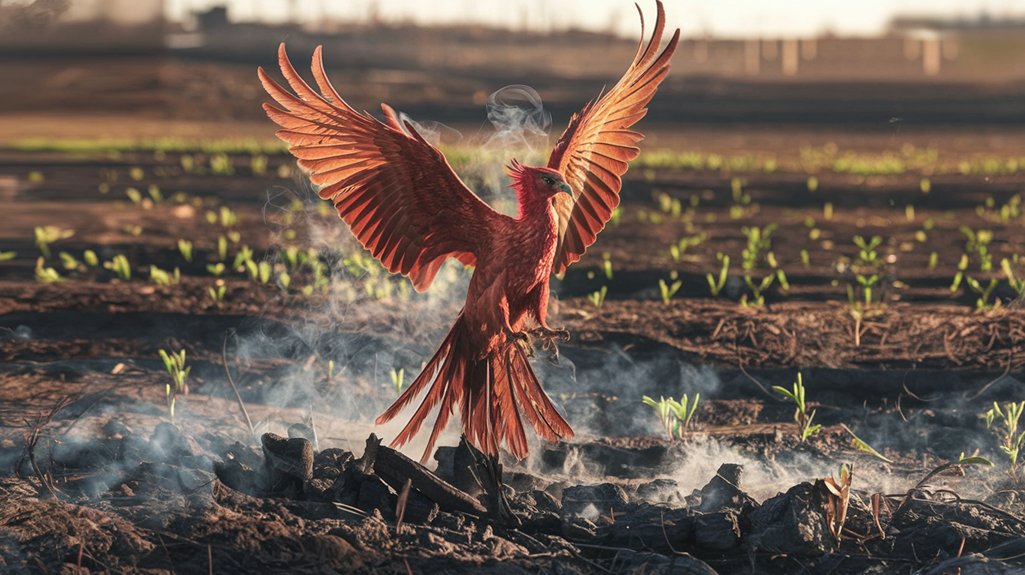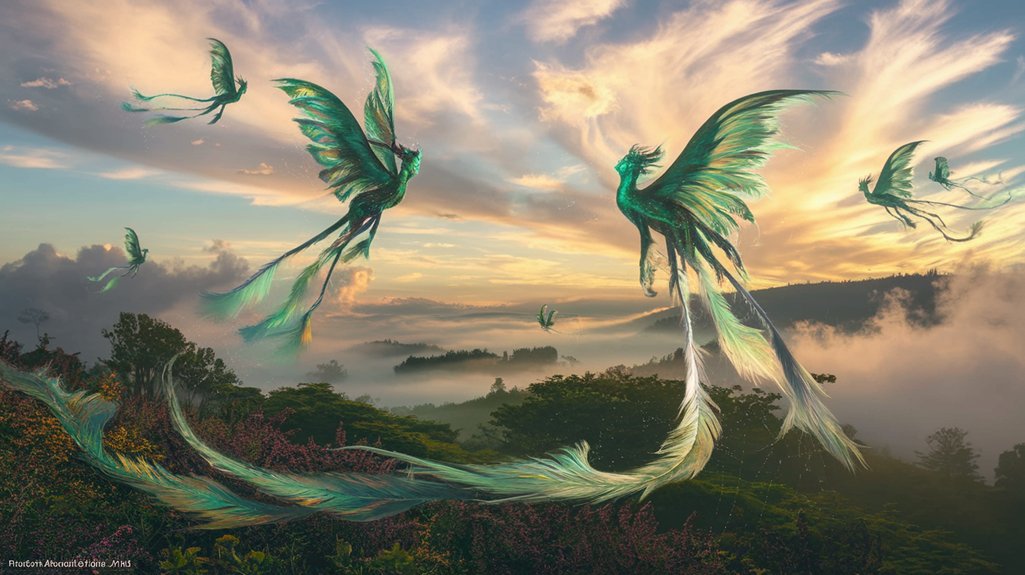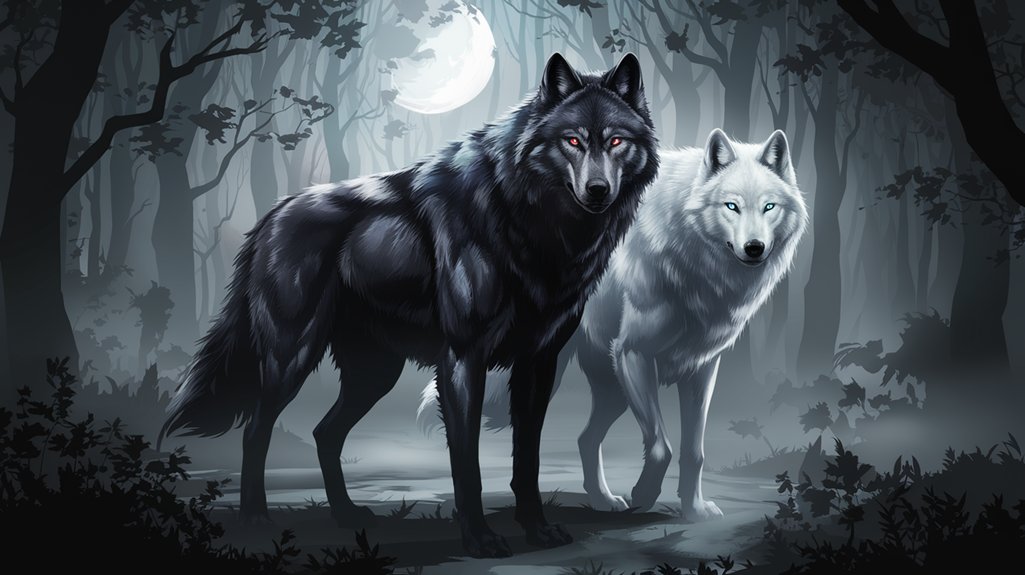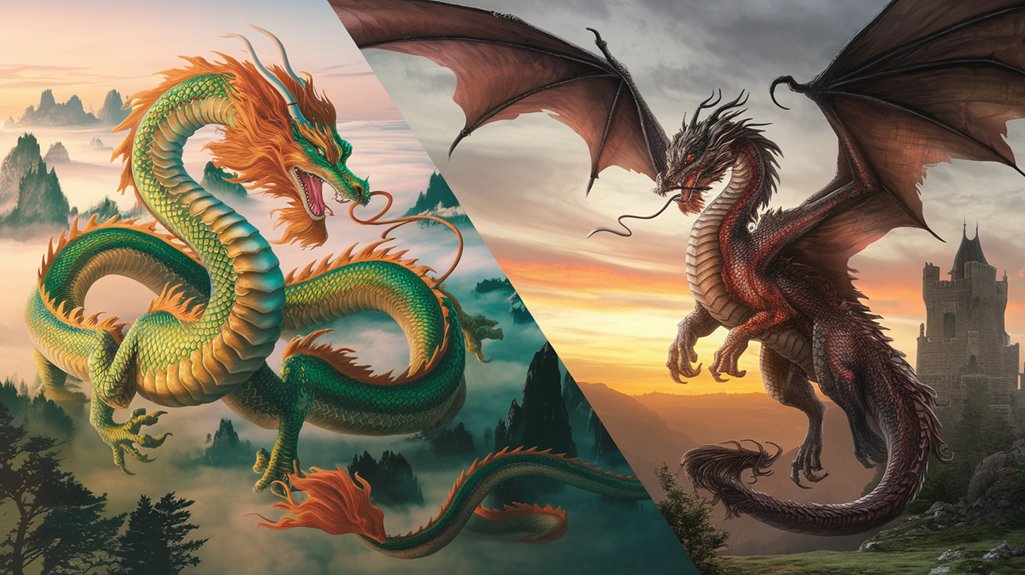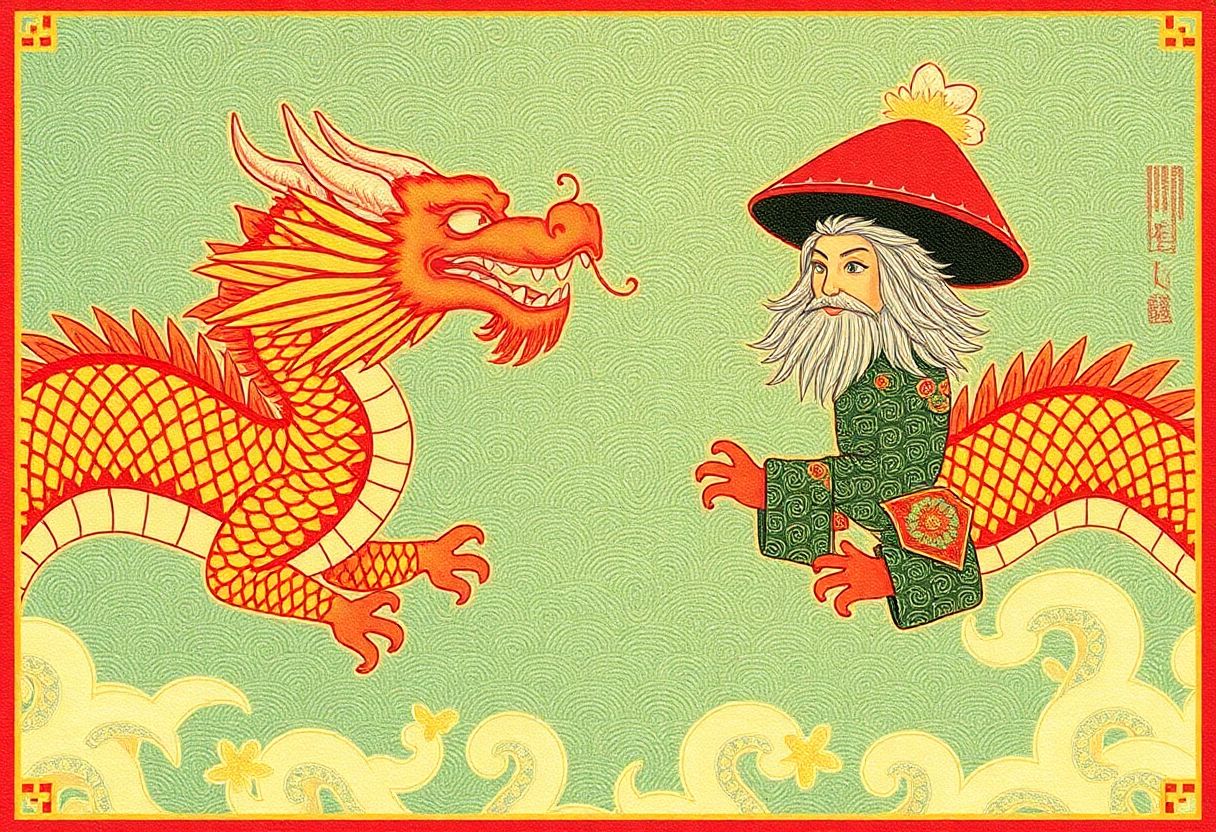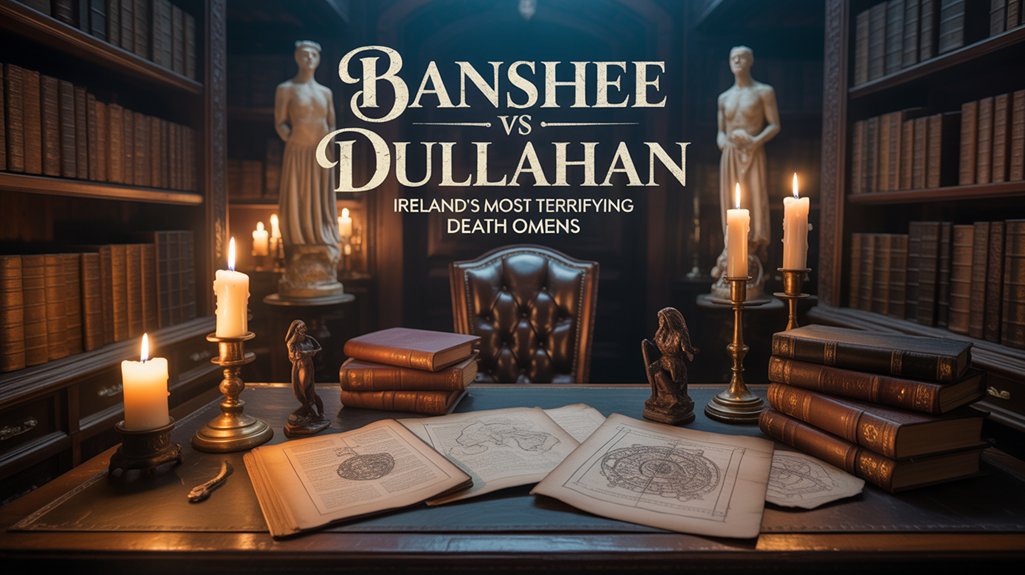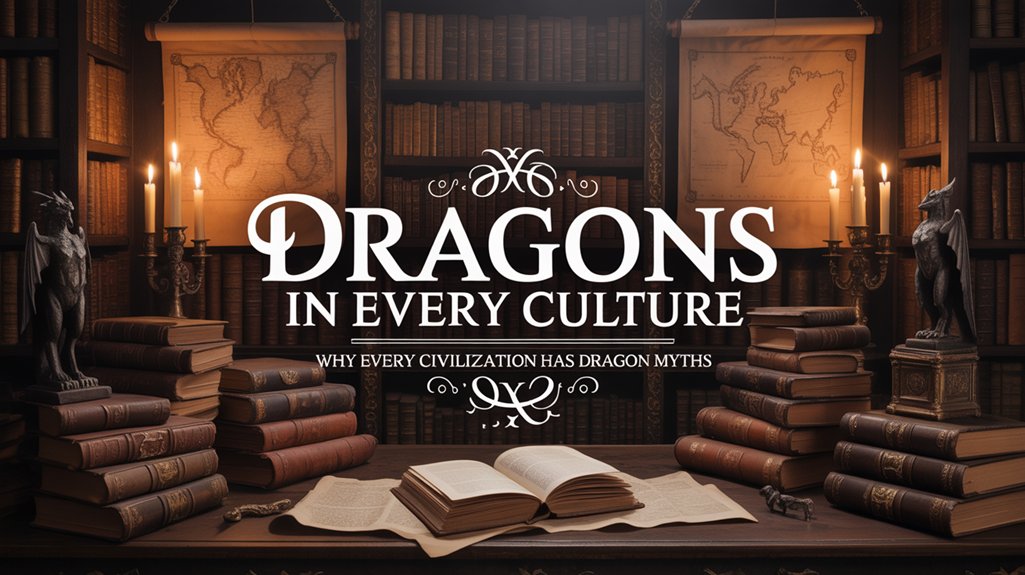You might think dragons are merely mythical creatures, but their lore has deeply influenced ancient cultures. Imagine a world where these majestic beings are not just stories but powerful symbols woven into the fabric of society. From European legends to Chinese celestial dragons, they shaped perspectives on creation, destruction, and protection. Their presence in art and architecture hints at their lasting impact. Curious about these fire-breathers’ roles in shaping human history? Let’s explore further.
Table of Contents
ToggleKey Takeaways
- Dragons in ancient cultures symbolized power and protection, often depicted as guardians of sacred sites and treasures.
- Chinese dragons controlled weather and were revered for their divine wisdom and strength, influencing agricultural prosperity.
- Dragon legends served as metaphors for personal growth and liberation, encouraging courage and self-determination against oppression.
- Dragon imagery in art and architecture embodied chaos and guardianship, shaping historical narratives and inspiring reflection on nature’s power.
- The dual nature of dragons, as creators and destroyers, taught lessons of balance, wisdom, and renewal in ancient lore.
Dragons in European Mythology
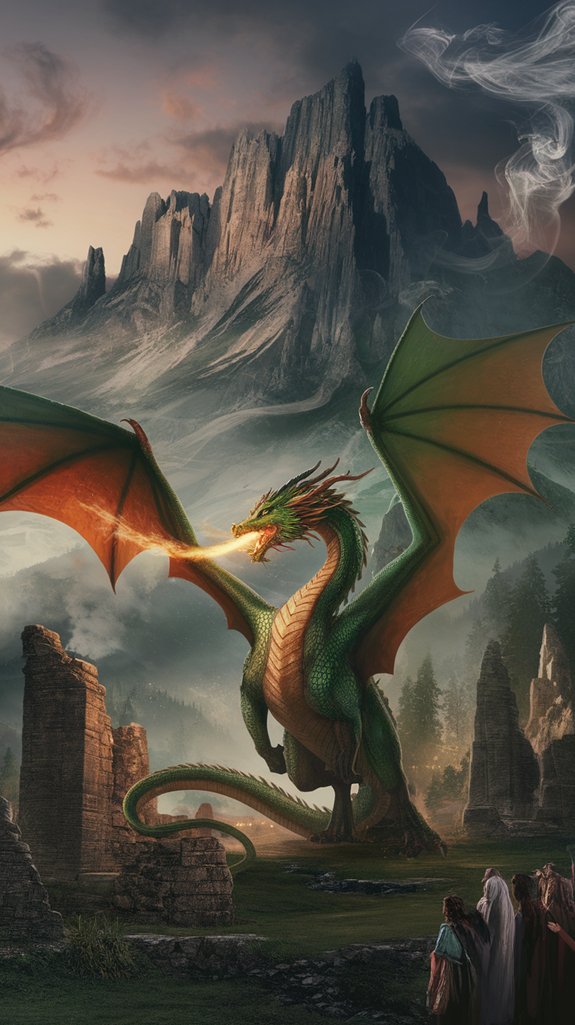
Although dragons seem like mere mythical creatures to us today, they once held a firm grip on the European imagination, symbolizing both fear and fascination. These legendary beasts, depicted with immense power, were often more than just adversaries; they represented life’s ultimate challenges. As you delve into dragon legends, you’ll discover tales of dragon slayers like St. George and Siegfried, who weren’t just battling monsters but standing against tyranny and chaos. Such stories served as metaphors for the eternal struggle for freedom and self-determination.
In medieval Europe, dragons weren’t just symbols of terror but also of opportunity. Confronting these creatures in folklore meant confronting one’s own limitations and fears, a narrative that resonated deeply in an era of feudal oppression. The allure of dragon legends lay in their promise of transformation and liberation, offering the bold a chance to rewrite their destinies, challenging the status quo through courage and cunning.
The Celestial Dragons of Ancient China
In contrast to the fearsome dragons of European tales, the celestial dragons of ancient China evoke reverence and awe. As you delve into their world, you discover creatures woven into the very fabric of the cosmos. Chinese celestial dragons aren’t mere beasts but embodiments of divine wisdom and strength. They traverse the skies, controlling rain and weather, essential for agriculture and prosperity.
Dragon symbolism in China transcends earthly concerns, reaching into the spiritual realm. These dragons represent balance and harmony, often seen as intermediaries between heaven and earth. Their celestial significance can’t be overstated, serving as a bridge to understanding the universe’s mysteries.
You see these dragons adorning temples, their images a reminder of their revered status. They fuel imaginations and inspire a sense of wonder, urging you to reflect on the freedom found in embracing nature’s power and the unknown, unchained by earthly constraints.
Dragons as Symbols of Power and Protection

You’ll find dragons portrayed as mighty guardians in the myths of various ancient cultures, where they often protect entire empires from harm. As royal emblems and insignias, these creatures symbolize the ultimate authority and strength of kings and emperors. Beyond their worldly influence, dragons also serve as spiritual symbols of protection, believed to ward off evil and ensure prosperity.
Mythical Guardians of Empires
When exploring the rich tapestry of ancient cultures, you can’t ignore the powerful symbolism of dragons as mythical guardians of empires. These majestic creatures weren’t just fearsome beasts; they represented the ultimate protectors of vast realms. Imagine emperors and kings, seeking to fortify their dominion, adopting the dragon’s image as a guardian. The dragon’s presence implied strength and invincibility, a deterrent against would-be invaders. As you delve deeper, you’ll find dragons often depicted on monuments, standing watch over cities and palaces. They weren’t merely decorative; they embodied vigilance and authority.
In societies yearning for freedom and security, dragons offered a promise of unyielding protection. They inspired awe and respect, becoming eternal symbols of power and guardianship across diverse cultures.
Royal Emblems and Insignias
Dragons have long served as regal emblems, etched into the insignias of royalty to signify power and protection. Picture a time when kingdoms stretched across vast lands, rulers craving symbols that captured their dominance and guardianship. Dragon symbolism offered an irresistible allure—its fierce imagery and mythical strength resonated with the ambition of those in power. You’d find these majestic creatures woven into royal insignias, their sinuous forms gracing banners, shields, and crowns. Dragons didn’t just represent authority; they embodied the freedom to rule, to protect one’s realm from threats. In your journey through history, notice how these iconic beasts inspired leaders to embrace their inner fire and assert their will over their domains, forever seared into the annals of royalty.
Protective Spiritual Symbols
As you journey from royal insignias adorned with dragons to their broader role as protective spiritual symbols, a fascinating tapestry of cultural beliefs and practices unfolds. Dragons, revered as spiritual guardians, weave through the myths of civilizations, instilling both awe and assurance. In China, they symbolize auspicious power, warding off evil and ensuring prosperity. Meanwhile, in the Celtic world, dragons represent earth’s primal forces, serving as protectors of sacred lands. Each dragon’s roar is a reminder of strength and vigilance, a silent promise of safety. Across cultures, their enduring presence highlights their cultural significance as embodiments of power and protection. By embracing these majestic creatures, you tap into a legacy that champions freedom and the courage to safeguard what you hold dear.
The Dual Nature of Dragons: Creators and Destroyers
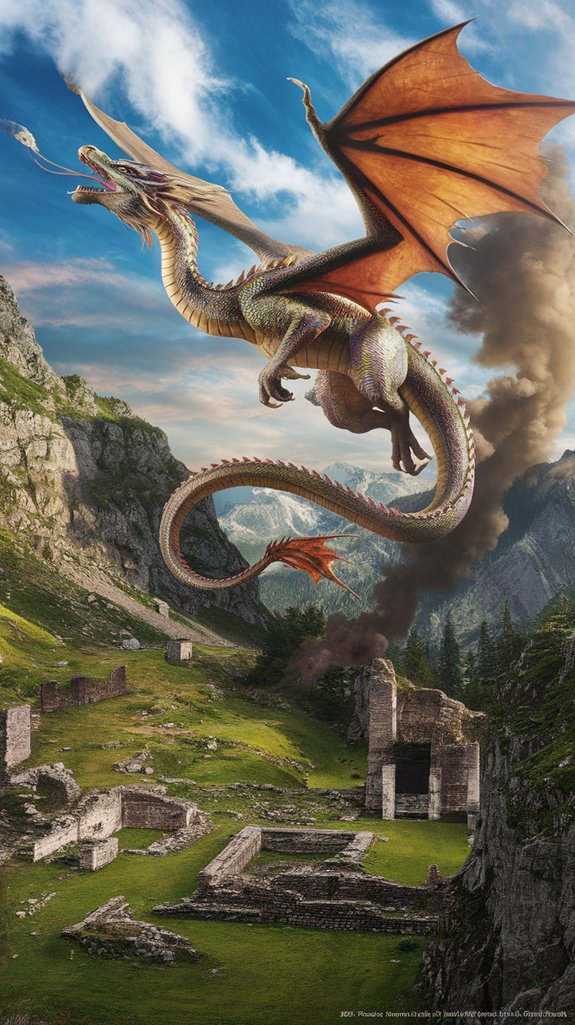
Although often depicted as fearsome beasts, the dual nature of dragons in ancient lore reveals them as both creators and destroyers, embodying a complex duality that many cultures explored. You’ll find dragons woven into creation myths, where they breathe life into the world, nurturing it. Yet, they also feature prominently in destruction legends, where their fiery breath obliterates the old to make way for the new. This cultural duality is fascinating, pulling you into an intricate dance of opposites.
Consider how dragons:
- Shape landscapes: They carve rivers and mountains.
- Guard treasures: Embodying guardian myths, they protect sacred sites.
- Symbolize power: Their presence signifies authority and strength.
- Teach lessons: Through destruction, they instill wisdom and renewal.
- Balance chaos: They maintain equilibrium between creation and ruin.
Embrace the freedom to explore these narratives, understanding how they mirror humanity’s struggles with creation and destruction.
Dragons in Art and Architecture
When you look at the intricate designs of ancient temples and medieval castles, the presence of dragon motifs becomes almost inevitable, weaving a narrative as old as the structures themselves. These creatures, bursting from stone and canvas, tell stories of power, mystery, and the celestial. You’re drawn to dragon murals that adorn the walls of sacred spaces, each stroke of the brush capturing the essence of a creature that transcends myth.
In the architectural motifs of towering castles and temples, dragons symbolize both guardianship and chaos. As you wander through these historic sites, you sense a dance between fear and reverence. Dragons perch atop spires, their stone scales glistening in the sunlight, reminding you of a time when legends shaped reality. By exploring these artistic representations, you’re not just witnessing history; you’re embracing the freedom to interpret and connect with a narrative that has long captured the human imagination.
The Enduring Influence of Dragon Lore in Modern Culture
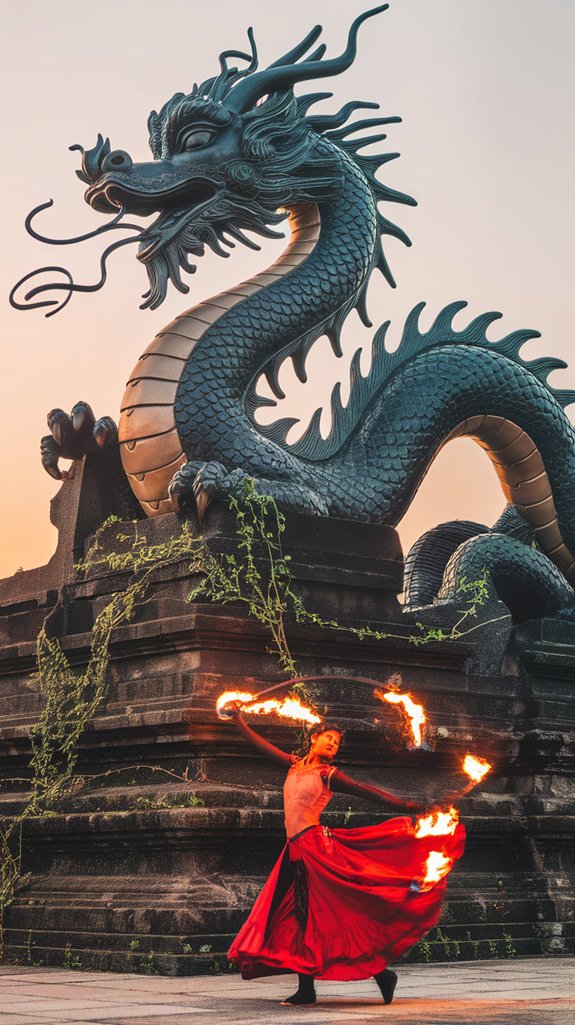
You can’t escape the presence of dragons in today’s pop culture, as they soar through films, books, and even video games. These mythical creatures, rich in symbolism, continue to captivate our imaginations, embodying themes of power, mystery, and transformation. By weaving modern myths around dragons, you’re connecting with a narrative thread that stretches back through centuries, illustrating their timeless appeal and adaptability.
Dragons in Pop Culture
Even as centuries pass and cultures evolve, the allure of dragons remains as potent as ever, embedding itself deeply within modern pop culture. You see it in the way dragon films captivate audiences, weaving tales that ignite the imagination and challenge the mundane. Dragon literature, too, continues to enchant readers, offering narratives where these mythical creatures symbolize power and freedom. Their presence is felt in various forms:
- Epic fantasy series like “Game of Thrones”
- Animated adventures such as “How to Train Your Dragon”
- Video games where dragons roar to life
- Comic books exploring dragon-filled worlds
- Merchandise markets that thrive on dragon imagery
Dragons inspire a sense of wonder, offering a narrative that transcends time, drawing you into worlds where anything is possible.
Symbolism and Modern Myth
While modern culture evolves, the symbolism of dragons remains a powerful mythic force that shapes narratives across various mediums. You see dragons as guardians of wisdom and chaos, embodying freedom and mystery. Modern interpretations span literature, films, and games, offering diverse meanings that resonate with personal and societal quests for power and liberation. Dragon symbolism persists because it adapts to shifting cultural contexts, embodying both fear and fascination.
| Medium | Dragon Symbolism | Modern Interpretations |
|---|---|---|
| Literature | Wisdom and Power | Personal Growth |
| Films | Good vs. Evil | Moral Ambiguity |
| Games | Challenges and Rewards | Skill and Strategy |
| Art | Transformation | Creativity and Rebirth |
| Fashion | Boldness and Style | Individual Expression |
Embracing this mythic force, you find new ways to interpret and understand your world.
Frequently Asked Questions
How Did Dragons Influence Ancient Agricultural Practices?
You’re exploring how dragons influenced ancient agricultural practices. Dragon symbolism often tied to crop fertility, inspired rituals seeking bountiful harvests. By invoking dragon myths, communities aimed to ensure freedom from famine through abundant, thriving fields.
What Role Did Dragons Play in Ancient Medicine?
You see dragon symbolism in ancient medicinal practices as transformative, symbolizing strength and healing. They inspired herbal remedies and rituals, helping societies frame medicine as a powerful force, freeing individuals from illness and celebrating life’s vigor.
Were Dragons Associated With Any Specific Natural Disasters?
Imagine a village overlooking a rumbling volcano. You’d see dragon symbolism in their disaster myths, believing dragons caused eruptions. This belief helped communities craft narratives of resilience, granting them freedom from fear through understanding nature’s fury.
How Were Dragons Depicted in Ancient Music or Dance?
You explore how ancient cultures infused dragon lore into their artistry. Imagine a dragon symphony’s majestic crescendo, while mythical choreography portrays dragons’ fierce elegance. These expressions offer a narrative of freedom and power, reflecting humanity’s wild imagination.
Did Ancient Dragon Lore Include Any Notable Female Dragons?
You’ll find that ancient female dragon legends often feature mythical dragon queens who wielded great power. These tales highlight their influence, showcasing their roles as rulers and formidable beings, inspiring cultures that valued strength and independence.
Conclusion
In your mind’s eye, picture dragons soaring across ancient skies, weaving tales of strength and mystery into the fabric of human history. Their fiery breath not only kindled fear but also ignited inspiration, bridging worlds and cultures. These majestic creatures, both creators and destroyers, painted vibrant tapestries of resilience and power. Even today, dragon lore whispers through our stories and art, a timeless testament to their enduring influence and the unyielding bond between humanity and the natural world.


